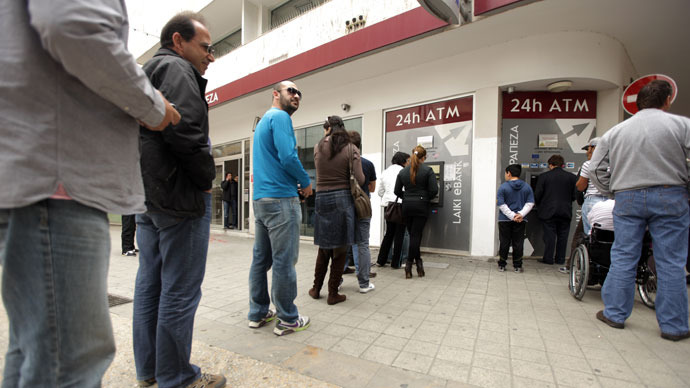 The banking crisis in Cyprus came as a sharp reminder to savers around the world that banks are not necessarily the safe havens they like to imagine.
The banking crisis in Cyprus came as a sharp reminder to savers around the world that banks are not necessarily the safe havens they like to imagine.
The plan to impose a 6.75% tax on savings up to €100,000 (NZ$153,000) and a 9.9% tax on savings above that was proposed by the Cyprus government as a way of raising the €5.8 billion they needed to find to qualify for a €10 billion International Monetary Fund (IMF) bailout.
However, politicians swiftly backed away from their plan to tax savings once they saw the depth of public fury.
Under the deal finally agreed with the IMF, Cyprus’s second largest bank, the Laiki, will be closed.
Bank closure
The Laiki Bank is 84% owned by the Cypriot government, following a €1.8 billion bailout last year, with the balance held by private and institutional investors, including bank staff.
All deposits of up to €100,000 will be transferred to the country’s biggest bank, the Bank of Cyprus, while €4.2 billion worth of deposits over €100,000 will be placed in a “bad bank” along with shareholder and bondholder funds, and will probably all be wiped out.
The Bank of Cyprus will also undergo a massive restructuring to return it to a healthy state. Thousands of staff will lose their jobs. Shareholders and bondholders are likely to lose their investments and all depositors with funds of over €100,000 are expected to face losses of around 30%
Overseas divisions of these banks are said to have some protection – those that are incorporated in other countries are effectively separate entities and as subsidiaries operate under a different set of rules.
Even those that are run as “branches” appear to have some measure of autonomy.
Russians lose
The biggest losers from the Cyprus banking crisis are undoubtedly Russian nationals.
They are estimated to own over €20 billion of the €68 billion deposited in Cypriot banks, with many holding deposits of over €100,000.
But with Cyprus having been widely recognised as an offshore finance centre and tax haven, the cost of having to rebuild their economy from the ruins of their banking system, will fall heavily on all citizens.
The economy has effectively been crushed with debt levels already standing at 143% of GDP. Once capital controls are lifted, more money will flee the system and the economy will continue to spiral down.
The Cyprus crisis has served to focus world attention on banking systems and governments. Most people still regard banks as large safe deposit boxes, with little concern for the security of their funds.
However, the reality is that bank deposits are risk investments – investors lend their saving to banks, who lend them on to those with inadequate savings.
Public opposition
But what the Cyprus government has also revealed is that when pressured by the terms of a bailout, cash strapped governments are not above dipping into the savings accounts of citizens for the purpose of gathering taxes.
This incident is a sharp reminder, and a warning, of the extraordinary power of governments.
In Cyprus, as in the case of other European Union countries, bank deposits of up to €100,000 are safeguarded by a retail deposit scheme, which protects small depositors in the event of a banking collapse.
That is why savings of up to €100,000 have been exempted from the bank restructuring changes that were announced in Cyprus.
Such schemes cannot protect depositors from government taxation; as Cypriots demonstrated, only strong public opposition can do that!
Lessons for New Zealand
So what are the lessons for New Zealand from the banking crisis in Cyprus?
Firstly, the events in Cyprus have highlighted the importance of having a strong economy and a strong banking sector. While we could always wish for more rapid economic growth, on a global scale New Zealand is not doing too badly, and our banking sector is amongst the most highly rated in the world.
Secondly, it demonstrates the importance of having provisions in place to enable a country to cope with a banking crisis as swiftly as possible and in a way that minimises collateral damage.
Fortunately the Reserve Bank of New Zealand (RBNZ) has been working on just such a scheme – Open Bank Resolution – which is almost ready for implementation.
Former RBNZ Governor Dr Don Brash mentioned the following:
“The reality is that while no bank is too big to fail, some banks are too big to close. It is not just that very large banks hold a huge portfolio of loans which keep the economy ticking over, and a huge volume of deposits, but mainly that all banks are closely linked through the electronic payments system. Pull one of the major components of that payments system out, and the whole system stops. The damage which would be done to the whole economy would be absolutely massive.”
According to Dr Brash, RBNZ has been working for more than a decade on how a distressed bank could be failed without being closed.
“As I understand current thinking, if a systemically important bank were to get into serious trouble, its shareholders would lose all their money, its board and senior management would be fired, and bank creditors (including depositors) would have a small proportion of the money owed to them by the bank frozen – but with the bank continuing to operate under statutory management,” he said.

Possible options
While any freeze on savings would be undesirable, it is important to look at the options. If a failing bank was allowed to close, depositors would almost certainly lose most of their savings – not to mention the huge damage a bank failure would inflict on the economy.
Freezing savings, with a view to eventually repaying the deposits in full, is therefore seen as the lesser of two evils.
Other options, of course, involve government bailouts, but the cost can be crippling.
Ireland’s government debt was only 25% of GDP before the Global Financial Crisis.
It is now over 100%, largely as a result of bank bailouts.
Deposit Insurance Schemes, of the sort that protected Cypriot depositors with savings of up to €100,000, are another variation, but New Zealanders have already experienced the problems associated with such schemes.
Failed System
The Labour Government introduced a Retail Deposit Guarantee Scheme as a temporary measure on October 12, 2008 during the dying days of its administration.
Since Australia had just introduced deposit guarantees, it was seen as a necessary step to maintain depositor confidence in New Zealand’s financial institutions during the worst of the Global Financial Crisis.
A Wholesale Guarantee Facility was introduced on November 1, 2008 to ensure that banks had access to international funding markets.
While the wholesale guarantee facility was closed down in April 2010, having issued 24 guarantee certificates covering $10.3 billion, netting the government $290 million in fees, the retail deposit guarantee scheme was extended to December 2011.
According to the Auditor General, 96 institutions were accepted into the Scheme.
These included 60 non-bank deposit takers such as finance companies and credit unions, 12 banks, and 24 collective investment schemes.
No banks accepted into the Scheme failed, and there was no run on the money in banks. No building societies or credit unions accepted into the Scheme failed.
However, of the 30 finance companies accepted into the Scheme, nine failed, triggering taxpayer bail-outs. About $2 billion was paid out to more than 42,000 depositors – the lion’s share being to investors in South Canterbury Finance, which had 35,000 investors and debts of $1.6 billion.
Perverse effect
When issuing its Regulatory Impact Statement in September 2009 on extending the retail deposit guarantee scheme, the Treasury noted that the scheme had a perverse effect on institutional behaviour, creating distortions in financial and capital markets.
These included encouraging guaranteed depositors and deposit taking institutions to make riskier investment decisions since the gains from these riskier decisions will be accrued by the depositors and deposit taking institutions, while potential losses to depositors (of up to $1 million per depositor per institution) will be borne by the taxpayer,
The Treasury defined this as a ‘moral hazard’ problem, and said that as a result of the guarantee, “finance companies (which tend to be involved in higher-risk and higher-return lending) have grown their deposit books by approximately $880 million (19%) since the guarantee was introduced in October 2008. Before the guarantee, the deposit books of many finance companies were shrinking. In some cases, finance companies have used retail funding to replace their bank funding lines.”
Major failure
The major failure was undoubtedly South Canterbury Finance, a finance company that grew far too quickly, and invested far too much of its funds in the risky property development sector. With the company reputed to have been in trouble as early as mid-2008, there are legitimate questions as to not only how it was able to gain approval for acceptance into the scheme in the first place, but also why it was able to enter the extended scheme on January 1, 2010.
The above is the edited version of the views expressed by Dr Muriel Newman, Director of the New Zealand Centre for Political Research, in her web-based free weekly Newsletter, NZCPR Weekly. For full text, visit www.nzcpr.com






